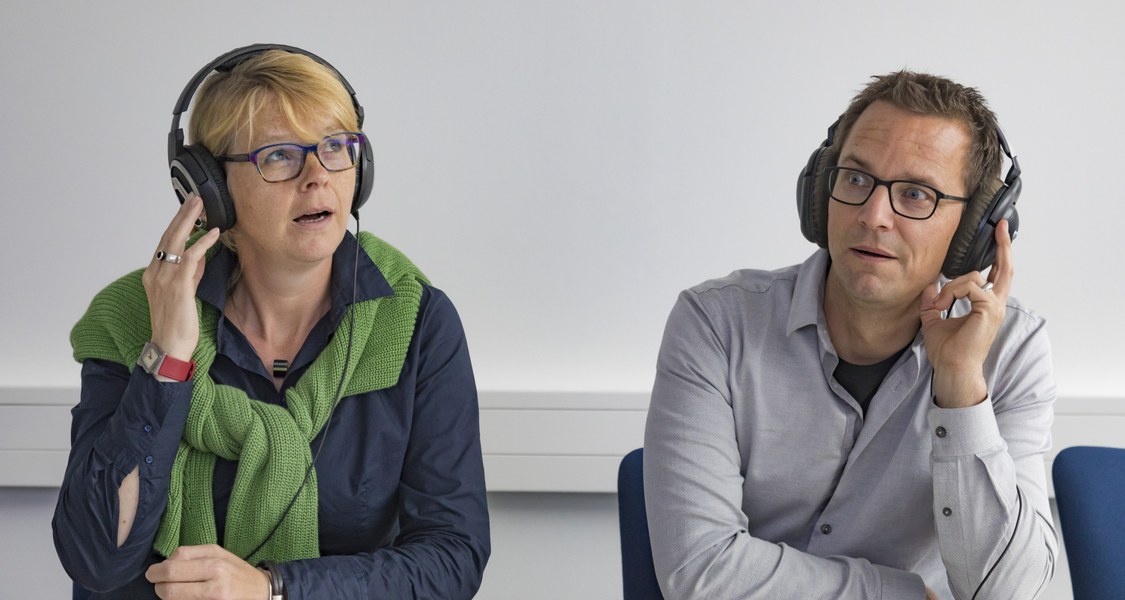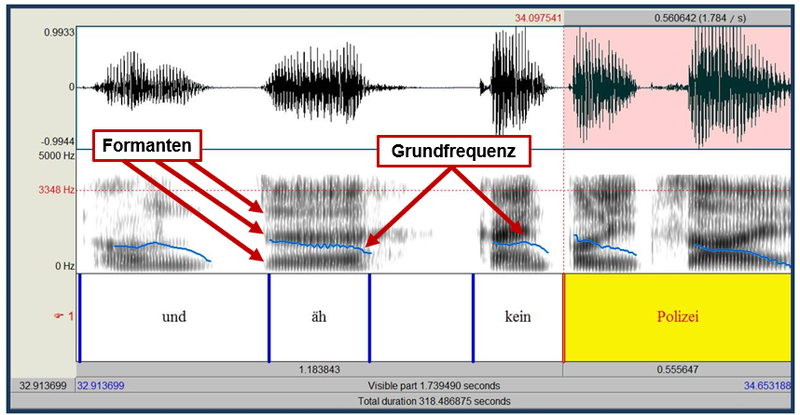Main Content
Forensic Phonetics

Contents:
- What is forensic phonetics?
- What does a forensic phonetician do?
- Are voices unique? Do "voice prints" exist?
- Dialectology in Marburg - Georg Wenker
- Studying forensic phonetics in Marburg
- Contact
- Literature
What is forensic phonetics?
„Forensic“ describes the use of scientific knowledge and methodology in the investigation and establishment of facts in a legal context.
„Phonetics“ is the scientific study of speech sounds. Phoneticians study the production and transmission of sounds and how these are perceived (Crystal, 2010; Kohler, 1977, p. 25).
Whereas forensic text analysts study written documents, the primary object of investigation for a forensic phonetician is the audio signal or the voice. In that sense, forensic phonetics can be understood as one of the applied phonetic sciences that deals with sound aspects that are relevant to the justice system.

What does a forensic phonetician do?
In the early sixties, the work of forensic phoneticians was primarily devoted to speaker identification (French, 1994). Since then, we have seen a diversification of tasks. At present, forensic phonetic areas comprise voice comparison, audio transcription and audio enhancement. Other less common tasks are speaker profiling, audio authentication and voice line-ups. A description of each task is provided in the table below. The exact distribution of task types may vary somewhat depending on whether a particular forensic team or expert has special expertise or a specific tool. An example of such a tool would be the dialect information system at the Research Centre of the “Deutscher Sprachatlas” at the University of Marburg described below (Schmidt, Herrgen, Kehrein & Lameli, 2008).
Tasks in forensic phonetics
Inhalt ausklappen Inhalt einklappen Voice Comparison
Speaker comparison is the analysis of two recorded speech samples by ear as well as by specialised sound and audio software. The disputed sample is the speech recording of an unknown perpetrator, e.g. the voice in the background of an emergency call or the bank robber shouting on footage of a security camera. The reference sample is the speech of a suspect, e.g. in a police interview, on a surveillance recording or in a recorded phone call. The aim of the phonetic analysis is to evaluate the degree of consistency between the samples and, where consistent, the degree of distinctiveness of the different features analysed.
Inhalt ausklappen Inhalt einklappen Audio transcription
Audio transcription consists of producing a detailed description of the contents of a recording. This does not only include speech, but also non-verbal material like crying, barking, doors closing, beeps of an answering machine, car engine noises, gun fire, etc.
The transcript serves two purposes: 1) to assist in forensic investigations: there might be surveillance recordings from a car that was used to transport drugs or a “Black Box” recording is recovered from a crashed plane; 2) to be used as incriminating evidence in court (e.g. The defendant may mention the transfer of money on tape AS2).Inhalt ausklappen Inhalt einklappen Audio enhancement
The quality of a recording can be degraded by noise and distortion resulting from inadequate equipment and recording methods or the acoustic environment in which it was produced. The intelligibility of a recording can be enhanced through the application of digital frequency filters and through the use of high quality equipment. In a first stage, specialised software is used to analyse the spectral characteristics of the signal. Based on this analysis, filters are constructed e.g. to reduce the intensity of particular frequencies (in the case of distracting noises such as mains hum, wind or ventilators) or to increase speech frequencies, both to improve the intelligibility of the recording.
Inhalt ausklappen Inhalt einklappen Speaker profiling
A speaker profile is requested for intelligence purposes and consists, if possible, of a description of speaker features to limit the number of possible suspects. These features may include the sex of the person, an estimation of their age, dialect, foreign accent, idiosyncrasies or even the level of education or profession based on the sociolect or jargon used by the speaker.
Inhalt ausklappen Inhalt einklappen Audio authentication
Audio authentication means examining whether the recording is authentic or whether it has been modified. Authentication analysis may also include assessing how the recording was made and which equipment was used.
Inhalt ausklappen Inhalt einklappen Voice line-ups
Voice lineups includes assisting the police in the construction of a voice identification parade. This procedure is applied in cases where a witness has heard the voice but not seen the face of the speaker and a recording of the crime does not exist.
Are voices unique? Do "voice prints" exist?
The term "voice print" is considered problematic by forensic speech experts using the non-automatic auditory/acoustic analysis method. It suggests that there is a unique and stable voice print that can distinguish individuals as much as fingerprints can. Unlike fingerprints however, variability occurs at a number of different levels in the speech process (Nolan, 1991). Some of it can be controlled, for example speaking style (e.g. the use of formal versus informal language or the speed of articulation), whereas some of it is imposed like changes concerning a speaker’s physical state (e.g. a cold may give a speaker’s voice quality a hyponasal quality).
As a consequence, formulating the outcome of a speaker comparison analysis as: “Speaker A heard on audio recording X is indeed Mr. Blofeld” would theoretically be incorrect. Instead, forensic experts will (normally) formulate their findings in terms of probabilities, as recommended in the casework guidelines of the European Network of Forensic Science Institutes (ENFSI 2015), in their reports .
We are members of The International Association for Forensic Phonetics and Acoustics (IAFPA). This is the professional association for forensic scientists and researchers who analyse voices, speech and audio recordings. As members, we follow the IAFPA standards of professional conduct and procedure described in their Code of Practice.
Dialectology in Marburg - Georg Wenker
A dialect may take the form of a small number of dialectal features in the otherwise fairly standard variety to a large number of deviations from the standard language in a rather traditional dialect. In the case of a speaker profile, a detailed feature analysis may give the phonetician an idea of the region, where the speaker spent their youth, or where the foreign speaker may have learnt their German.
The Deutsche-Sprach-Atlas in Marburg is particularly fortunate to have inherited the old dialect maps of Georg Wenker (1852–1911), a linguist who collected dialectal information from approximately 40,000 different places in Germany. The Wenker database was incorporated into a dialectological Information System called REDE (www.regionalsprache.de) together with another 30 linguistic databases on German dialects and a number of related/neighbouring languages like Dutch and Frisian.
Using the REDE system in the case of a speaker exhibiting dialectal features, it is possible to identify a region based on the area that all feature filter maps share.
Studying forensic phonetics in Marburg
Do you want to train as a forensic phonetician in Marburg?
Inhalt ausklappen Inhalt einklappen If you are looking to obtain an MA degree:
MA Sprechwissenschaft und Phonetik:
Follow the forensic route within the MA Sprechwissenschaft und Phonetik. This degree not only offers modules focused on forensic phonetics but also other courses such as acoustic phonetics and IPA-transcription are taught from a forensic perspective.
Important: although all forensic courses are taught in English, other courses that are part of the standard curriculum are in German.Inhalt ausklappen Inhalt einklappen If you are looking to do a short-term visit:
National and international students can also visit for a semester either as part of an exchange program (e.g. ERASMUS, ERASMUS+), a free mover, or a guest student (Gasthörer*in). Information can be found here.
Inhalt ausklappen Inhalt einklappen Courses
The following courses, all taught in English, may be useful for visitors with a forensic interest:
MA-Sprechwissenschaft und Phonetik:
Forensic phonetics (lecture: Forensische Phonetik 1)
Speaker recognition (seminar: Forensische Phonetik 2)
ATH2 - narrow IPA-transcription of dialects/foreign languages (tutorial: Transkription 1)BA-Sprache und Kommunikation:
ATH1 – Basics of IPA transcription (tutorial:: Wissenschaftliche Methoden in der Linguistik: ATH I)They are only offered during summer terms (mid-April until mid-July). Exact term dates can be found here.
Contact person
If you have questions about a course or degree or to ensure a place for yourself, please write an email to Gea de Jong-Lendle: dejong@staff.uni-marburg.de. It is recommended you do this well before your visit to Marburg, so that we are able to make the proper arrangements.
For speech analysis or general consultancy, please also contact Gea de Jong-Lendle: dejong@staff.uni-marburg.de.
Literature
Inhalt ausklappen Inhalt einklappen Introductory
- de Jong-Lendle G. (2022) Speaker Identification. In: Guillén-Nieto V., Stein D. (eds) Language as Evidence. Palgrave Macmillan, Cham. https://doi.org/10.1007/978-3-030-84330-4_9
- Gfroerer, S., and M. Jessen (2022). ‘Sprechererkennung und Tonträgerauswertung’, in Eckhart Müller and Reinhold Schlothauer and Christoph Knauer (eds), Münchener Anwaltshandbuch Strafverteidigung (3. überarbeitete Auflage). München: Beck, 2862-2890.
- Hollien, H. (1990) The Acoustics of Crime. Plenum Press: New York.
- Jessen, Michael (2012) Phonetische und linguistische Prinzipien des forensischen Stimmenvergleichs, Lincom: München.
- Künzel, HJK. (1987) Sprechererkennung. Grundzüge forensischer Sprachverarbeitung. Heidelberg.Inhalt ausklappen Inhalt einklappen Advanced
- Hollien, H. (2002) Forensic Voice Identification. Academic Press: San Diego.
- Rose, P. (2002). Forensic Speaker Identification. Taylor & Francis: London.
- Nolan, F.J. (1997) Speaker recognition and forensic phonetics. In W.J. Hardcastle & J.Laver (eds.) The Handbook of Phonetic Sciences. Oxford: Blackwell. pp. 744-767